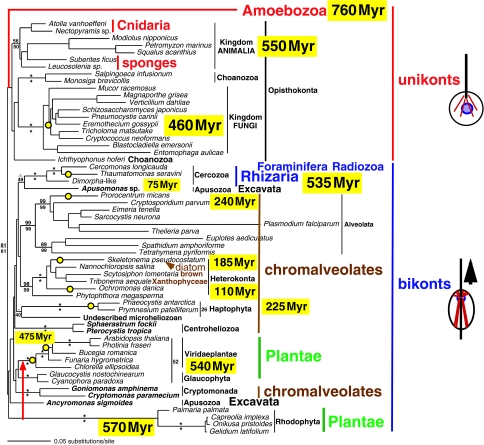Figure 7.
Distance tree for 58 eukaryotes based on 2994 nucleotides of 28S rRNA. This weighted least squares power 2 (GTR+Γ+I model: a=0.59231, i=0.24389) tree is from von der Heyden (2004). Numbers at major nodes only from 500 wl2 bootstrap samplings (limited to 10 min per replicate) (upper) and from 1000 BioNJ replicates (lower) are percentages of recovery of that clade (asterisks indicate 100%). Dates are for the earliest unambiguous fossils; if not otherwise obvious, dated clades are marked by yellow-filled open circles. The great variability in branch length shows that rRNA evolution is extremely non-clock-like; the still-longer-branch Amoebozoa, Foraminifera, Euglenozoa and Metamonada were omitted to reduce tree distortion and increase legibility; the position of Amoebozoa based on other evidence is shown in red. Foraminifera and Radiozoa (non-phaeodarian radiolaria) constitute the phylum Retaria, which is probably sister to Cercozoa (Cavalier-Smith 1999, 2003b). As in most single-gene trees, the monophyly of Plantae, chromalveolates and Apusozoa is not recovered. Red algae (Rhodophyta) are too low on this tree because of their very long branch, and are really sisters of Viridaeplantae (red arrow); as previously suggested for 18S rRNA (Cavalier-Smith et al. 1996), the gross acceleration in 28S rRNA evolutionary rate could have been entirely in the stem of the florideophyte red algal tree (bangiophytes have relatively normally short branches on 18S rRNA; also true for recent 28S sequences, unavailable for this analysis) as its branches have a phylogenetic depth comparable to their green-plant sisters. Thus, the ancestral florideophyte ribosome probably underwent marked episodic quantum evolution, somewhat less extreme than in the long stems at the base of the eukaryote and neomuran clades that gave rise to the misleading three-domain concept of the tree of life (Cavalier-Smith 2002a). The thumbnail sketches show that in addition to ciliary transformation from younger anterior to dissimilar older posterior organelles, bikonts have a microtubular cytosketeton (red) of cortical band ciliary roots, not a simple cone of separate microtubules like unikonts.

